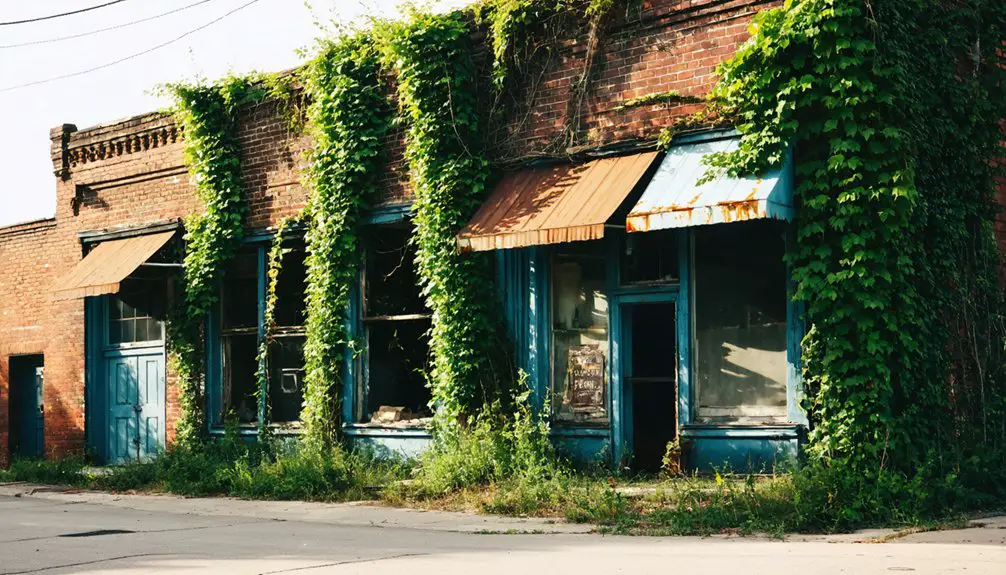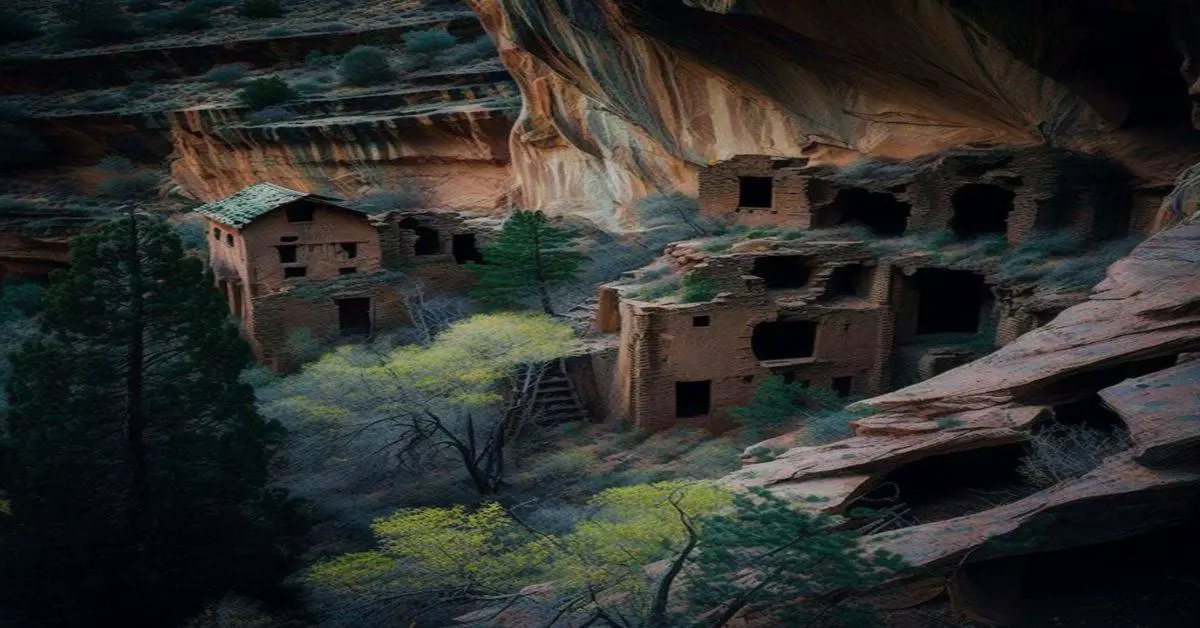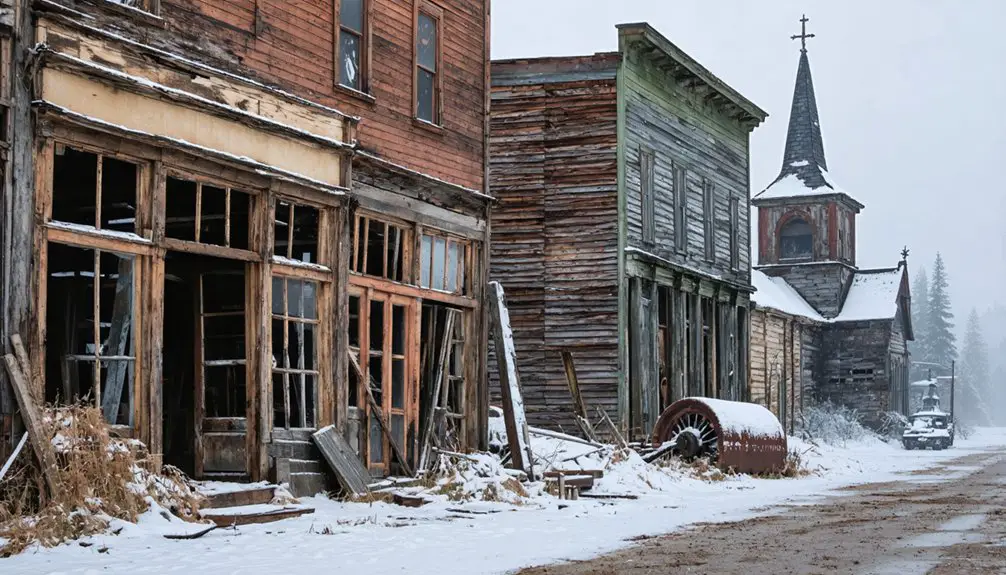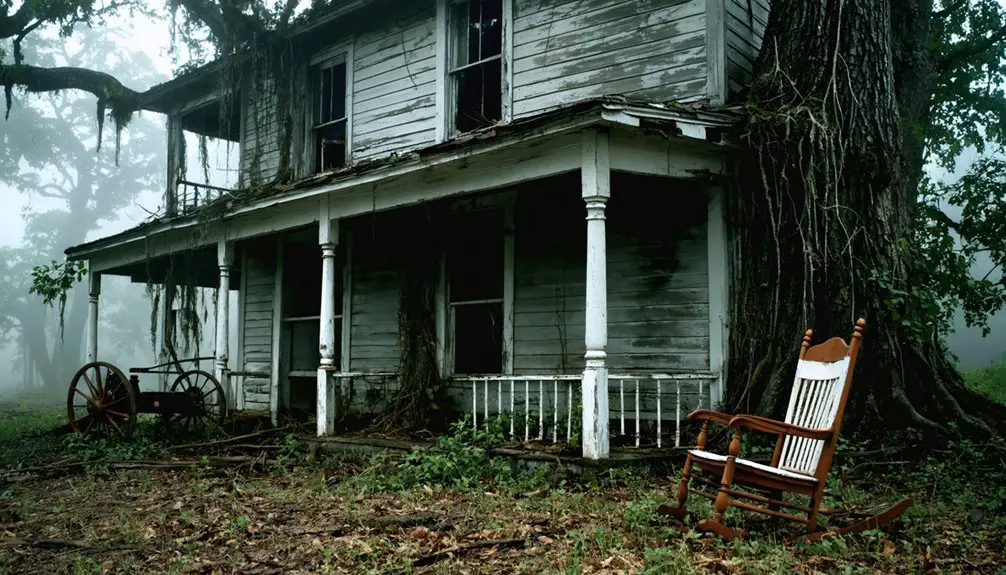You’ll find Gaymont’s abandoned remnants nestled in the steep Appalachian terrain of West Virginia, where the Chesapeake & Ohio Railroad once transformed this area into a bustling coal center in 1873. The ghost town’s weathered company houses, coal chutes, and railroad infrastructure tell stories of miners who lived under strict company control, using scrip currency at the company store. Through oral histories and artifacts, Gaymont’s rich legacy of resilience and cultural heritage beckons exploration.
Key Takeaways
- Gaymont was established as a coal mining town after 1870, following the arrival of the Chesapeake & Ohio Railroad in 1873.
- The town was controlled by Gaymont Fuel Company, which provided basic three-room company housing and maintained strict social control.
- Residents depended on company stores and scrip currency, with 80% of miners living in company-owned housing.
- The site features remnants of wood-frame houses, coal chutes, and a company store complex with medical facilities and mortuary.
- The abandoned town sits in challenging Appalachian terrain, facing ongoing issues with land subsidence, water accumulation, and unstable ground.
The Rise of a Coal Mining Community
While coal’s presence in West Virginia was first documented in 1742 along the Coal River, the region that would become Gaymont didn’t see significant mining development until after 1870.
You’ll find that mining innovations took hold as the Chesapeake & Ohio Railroad‘s arrival in 1873 transformed this remote mountain area into a bustling coal center.
The town’s growth reflected the era’s rapid industrialization, with independent speculators and mining companies acquiring mineral rights along the railway.
Community resilience emerged as workers, including many immigrants, flocked to Gaymont seeking opportunity. Early miners relied on basic tools like picks and shovels to extract coal from surface deposits.
The coal company established housing, infrastructure, and support services, creating a self-contained community. Workers often received their wages in company scrip instead of cash, which could only be used at company-owned stores.
Though the company maintained strict control over daily life, the town flourished as coal production soared and worker families built their lives around the mines.
Life in Company-Owned Housing
If you’d lived in Gaymont’s company housing during its heyday, you’d have found yourself in a basic three-room dwelling built by Gaymont Fuel Company to their standardized specifications.
The houses stood shoulder-to-shoulder in dense rows, creating tight-knit neighborhoods where miners and their families shared similar living conditions regardless of their job status.
Your home would’ve lacked modern amenities like proper insulation or central heating, reflecting the utilitarian approach coal companies took toward worker accommodations.
The company maintained significant control over the area, operating on mineral estates that covered over 2,500 acres of land.
Through careful management of their land holdings, Gaymont Fuel Company secured their interests with deeds of trust dating back to 1932.
Living Conditions and Challenges
As residents of Gaymont settled into company-owned housing, they faced stark living conditions shaped by the coal company’s tight economic control.
You’d find yourself living in a basic three- or four-room dwelling, identical to your neighbors’ homes, with little opportunity for personalization or improvement. Despite the community’s resilience, economic exploitation dominated daily life through company scrip, inflated store prices, and the constant threat of eviction. Any pay raises were quickly offset by increased housing costs imposed by the company.
Your family’s security depended entirely on compliance with company rules, as private guards monitored your activities and could force you out of your home for joining unions or strikes. Housing assignments reflected the town’s rigid social hierarchy, with administrators occupying larger homes in better locations while miners were relegated to the outskirts.
The lack of basic infrastructure and communal facilities intensified the isolation, while unsanitary conditions and poor maintenance put your family’s health at risk.
Basic Housing Construction Standards
Since federal agencies like NIST began establishing technical expertise roles in the early 20th century, company-owned housing had to meet increasingly stringent building codes and standards.
Following the example of The Great Fire of London, these regulations emphasized fire prevention to protect workers’ lives and company assets.
If you’d lived in Gaymont’s company housing, you would’ve seen the evolution of housing regulations firsthand. Early codes focused primarily on fire safety, requiring specific roofing materials and chimney specifications to prevent disasters common in mining towns. The National Board Underwriters established the first model code in 1905 to guide these safety requirements.
You’d have noticed improvements in structural integrity as new safety standards emerged, especially regarding wind and flood resistance. By the post-WWII era, your home would’ve needed to comply with expanded requirements for natural light, sanitation, and waste treatment.
The “Hoover Code” of 1928 brought stricter plumbing standards, ensuring you’d clean water and proper waste disposal – essential upgrades for the crowded conditions of company towns.
The Chesapeake & Ohio Railroad’s Impact
When the Chesapeake & Ohio Railway completed its final spike at Hawks Nest in 1873, it transformed southern West Virginia’s economic landscape.
You’ll find that this railroad expansion revolutionized the region’s accessibility, connecting the Ohio River to the Atlantic Ocean and opening vast coal resources to new markets.
The C&O’s impact reached far beyond just transportation. You can trace the birth of several towns directly to the railroad’s presence, including Huntington, Hinton, and Thurmond. The railroad’s founders, led by Collis P. Huntington, established these strategic locations to support the growing network.
More than 7,000 workers, including many African Americans, carved through the challenging terrain of the New River Gorge, creating tunnels and establishing crucial trade routes. The railroad became immortalized in the legendary tale of John Henry versus machine, capturing the spirit of human determination during this era of rapid industrialization.
This massive engineering feat didn’t just move coal and timber – it created jobs, established communities, and laid the foundation for West Virginia’s industrial growth for generations to come.
Daily Routines of Mining Families
The daily lives of mining families in West Virginia’s coal camps revolved around three rigid pillars: the company’s control, the miner’s grueling schedule, and basic survival.
You’d find miners rising before dawn, around 4 a.m., eating a simple breakfast of biscuits or cornbread before descending into dangerous mine shafts.
While men toiled underground, family dynamics centered on women managing households under the company’s watchful eye. You couldn’t escape the company’s influence – they owned your house, controlled your shopping through company script, and monitored your social activities.
To maintain some independence, families often raised livestock and grew vegetables. Their dietary habits relied heavily on home-produced food, supplemented by expensive goods from company stores.
Despite these constraints, mining communities formed tight-knit social bonds within their isolated mountain settlements.
Architecture and Building Remnants
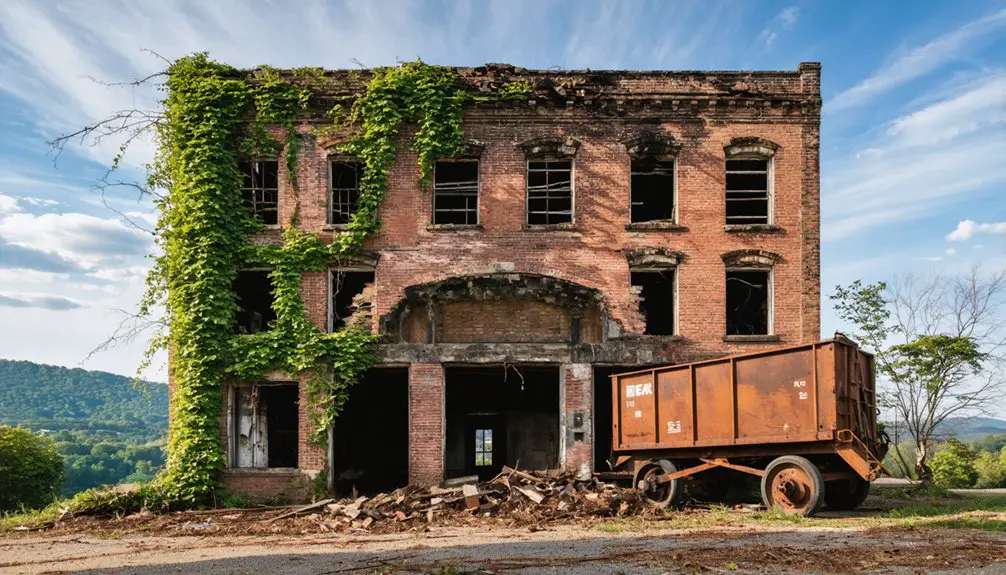
Rugged remnants of Gaymont’s coal town architecture tell a stark story of industrial efficiency and basic survival.
You’ll find wood-frame houses with distinctive coal chutes and outdoor kitchens dotting the landscape, their weathered foundations standing as evidence to working-class life. The architectural decay reveals both domestic and industrial priorities – from strategically positioned mine entrances to the massive tipples that once processed the region’s black gold.
Faded coal chutes and crumbling kitchen walls tell stories of miners’ lives, where industrial needs shaped every architectural choice.
At the heart of town, you’ll discover the historical significance of the company store, built more robustly than surrounding structures, with its integrated medical facilities and basement mortuary.
Railroad infrastructure weaves throughout, connecting various elevation levels via bridges, trestles, and mountain haulage systems. These architectural elements showcase how the community adapted to the challenging terrain while serving the coal industry’s demanding needs.
The Company Store System
Deep within Gaymont’s economic heart, company stores wielded unprecedented control over miners’ daily lives through an intricate system of commerce and social engineering.
You’d find yourself trapped in a carefully orchestrated system where the company store served as your only retail outlet, forcing economic dependency through company-issued scrip currency that couldn’t be spent anywhere else.
Like 80% of West Virginia miners by 1922, you’d have lived in company housing while relying on the store for everything from food to fuel.
The store complex dominated town life, housing essential services like the post office and payroll department.
Through this centralized control, companies maintained their grip on workers’ finances and social interactions, creating an inescapable web of dependency that extended far beyond simple commerce.
Environmental Challenges and Geography
Today you’ll find Gaymont’s remains nestled within steep Appalachian terrain that severely limited building space and transportation options during the town’s operation.
The New River Valley’s flood-prone nature, combined with extensive mining-induced land subsidence, created ongoing challenges with seasonal water accumulation and unstable ground conditions.
While much of the original mining infrastructure has deteriorated, nature’s gradual reclamation process has brought secondary forest growth and some ecological recovery to the area, though contaminated soils and unstable slopes continue to pose environmental hazards.
Mountain Terrain Limitations
Located within Fayette County’s Appalachian Highlands, Gaymont’s challenging mountain terrain posed significant limitations on development and land use.
You’ll find steep slopes exceeding 40% across one-fifth of the area, with hard sandstone knobs capping ridgetops and narrow valleys restricting flat land availability. These conditions create serious concerns about terrain erosion and slope stability, especially where mining activities have altered the natural landscape.
The region’s complex geology, featuring layers of sandstone, shale, and limestone, complicates construction and infrastructure development.
You’re looking at shallow soils prone to erosion, while the underlying karst features can compromise structural stability. Building here requires extensive grading and costly engineering solutions, limiting options for large-scale development and constraining economic growth potential.
River Valley Flooding
While the mountain terrain created development constraints, Gaymont’s position in the river valley brought its own set of challenges.
You’ll find that the narrow valley left little room for flood prevention infrastructure, making the town vulnerable to seasonal flooding from mountain snowmelt and heavy rains. The confined topography caused rapid water level changes, while the permeable valley soil quickly became saturated during storms.
The lack of effective river management took its toll on Gaymont’s structures.
Floodwaters eroded riverbanks, deposited sediment, and accelerated decay in wooden buildings through repeated exposure. You can trace the town’s decline partly to these persistent flooding issues, which damaged essential infrastructure like bridges and rail lines.
The costly cycle of flood damage and repairs ultimately contributed to the town’s abandonment.
Natural Reclamation Process
Since its abandonment, Gaymont’s natural reclamation process has been shaped by the unique geological features of southern West Virginia’s Fayette County.
You’ll find natural succession occurring as secondary forests gradually reclaim old mining sites, with oaks, maples, and tulip poplars taking root in the rocky Dekalb soils.
The ecosystem recovery faces distinct challenges in this rugged terrain.
You’re looking at steep cliffs up to 50 feet high, where massive sandstone outcrops create diverse microhabitats along the New River Gorge. While these conditions limit human access, they’ve encouraged wind-dispersed seeds to colonize naturally.
The biggest obstacles to reclamation include unstable slopes, seasonal water table fluctuations, and acid mine drainage from abandoned mines that continue to affect soil and water quality.
Tales From Former Residents
Former residents of Gaymont paint a vivid picture of daily life in this once-bustling coal town, where community bonds formed despite the harsh realities of company control.
Through personal anecdotes, they’ll tell you about walking treacherous paths to the mines before dawn, shopping with scrip at the company store, and gathering for community traditions at the local church.
The early morning trek to the mines, scrip in hand at the company store, church bells calling us home—this was our daily rhythm.
You’ll hear stories of neighbors helping neighbors, sharing what little they’d during tough times.
They’ll describe the pride of coal mining families, even as they faced daily dangers underground.
Their memories reveal both the strength of their tight-knit community and the vulnerability of depending entirely on the coal company.
When the mine finally closed, families were forced to abandon their homes, leaving behind not just buildings, but an entire way of life.
Historical Artifacts and Discoveries
Throughout Gaymont’s crumbling remains, historical artifacts tell the story of this once-thriving railroad town. At the restored Thurmond Train Depot, you’ll find original ticket windows and waiting room benches preserved through careful historical preservation efforts.
The Post Office and Commissary building houses an extensive collection of railroad memorabilia, while abandoned homes reveal pre-1920s furnaces and architectural elements that speak to early residential life.
Artifact conservation has protected significant discoveries, from the basement furnace in the James Humphrey House to the foundation stones of the infamous Dun Glenn Hotel.
Crime-related items, including recovered firearms and personal effects from unsolved cases, offer glimpses into the town’s tumultuous past. The depot’s second-story balcony, now a hotspot for paranormal activity, stands as a symbol of Gaymont’s enduring mysteries.
Legacy in Appalachian Culture
When you explore Gaymont’s remains today, you’ll find a powerful representation to how coal mining shaped Appalachian cultural identity through shared work experiences and community bonds.
The stories of mining life continue through local folklore, music, and craft traditions that preserve memories of both the town’s vibrant past and its eventual abandonment.
While Gaymont itself stands empty, the values of resilience and mutual support that defined its mining community live on in modern Appalachian culture, where descendants still honor their coal heritage.
Cultural Identity Through Coal
Deep in the heart of Appalachia, coal mining shaped the cultural fabric of communities like Gaymont for over two centuries, creating an identity built on shared experiences of hardship and resilience.
You’ll find this cultural resilience woven into the very essence of former mining towns, where families passed down not just jobs but entire ways of life through generations. The collective memory of mining work forged tight-knit communities, with shared language, traditions, and social bonds that defined who belonged.
Even as mines closed and economic hardship set in during the 1990s, these cultural ties remained strong. While poverty and health challenges have tested these communities, their connection to coal heritage persists.
It’s a complex legacy that encompasses both pride in their mining past and acknowledgment of its lasting environmental and social costs.
Mining Stories Live On
The rich tapestry of mining stories in Gaymont endures through generations of Appalachian families, preserving their coal heritage in vivid oral histories and artistic expressions.
You’ll find mining folklore woven into every corner of the community, from ballads sung at local gatherings to colorful murals depicting the town’s labor struggles. These narratives capture the essence of life underground – tales of heroic rescues, devastating accidents, and the unwavering solidarity among miners fighting for better conditions.
Today, even as Gaymont’s mines lie silent, you can still hear echoes of its mining past through the stories shared by former miners’ children and grandchildren.
Their accounts keep alive the legacy of union organizing, workplace battles, and the close-knit community that once thrived in this now-quiet hollow.
Community Values Endure Today
Resilience flows through modern-day Gaymont’s cultural veins, even as its mines stand dormant.
You’ll find the spirit of community solidarity alive in seasonal festivals and family reunions, where descendants gather to share stories of their coal mining heritage. Local artisans keep traditional crafts thriving through quilting circles and woodworking workshops, while musicians preserve age-old ballads that echo tales of life in the mountains.
Cultural preservation efforts extend beyond memories, as you’ll discover in regional museums and heritage centers.
They’re documenting Gaymont’s legacy through oral histories and artifact collections. Today’s environmental reclamation projects and heritage tourism initiatives reflect an evolving stewardship of the land, while educational programs guarantee that Appalachian values of perseverance and family bonds continue shaping new generations.
Frequently Asked Questions
Are There Any Documented Paranormal Activities or Ghost Sightings in Gaymont?
You’d expect a ghost town to have ghost stories, but surprisingly, there aren’t any documented spectral sightings in Gaymont, unlike other nearby coal towns in West Virginia’s New River Gorge.
What Happened to the Mining Equipment After the Town Was Abandoned?
You’ll find mining relics scattered across the abandoned site, as most equipment was either salvaged for scrap value or left to rust where it stood after operations ceased.
Can Visitors Legally Explore and Metal Detect in Gaymont Today?
You’ll need landowner permission and permits due to legal restrictions. Metal detecting isn’t allowed without authorization, as most ghost town areas are either private property or protected by preservation laws.
Were There Any Major Mining Disasters or Accidents in Gaymont?
Like pages torn from history’s book, you won’t find records of major mining disasters in Gaymont. While mining accidents plagued West Virginia, historical databases don’t show significant incidents at this specific location.
What Indigenous Peoples Inhabited the Gaymont Area Before Coal Mining Began?
You’ll find the Shawnee, Delaware, and Cherokee tribes held historical significance in the area, while Fort Ancient culture left archaeological evidence. Iroquoian-speaking groups like the Seneca and Mingo also influenced the region.
References
- https://kids.kiddle.co/List_of_ghost_towns_in_West_Virginia
- https://newrivergorgecvb.com/abandoned-wv-coal-towns/
- https://www.youtube.com/watch?v=yx2olDJivNQ
- https://www.youtube.com/watch?v=tU8B0h6jGdU
- https://en.wikipedia.org/wiki/List_of_ghost_towns_in_West_Virginia
- https://www.wvgs.wvnet.edu/www/geology/geoldvco.htm
- https://www.legendsofamerica.com/west-virginia-coal-mining/
- https://en.wikipedia.org/wiki/Monongah_mining_disaster
- https://www.youtube.com/watch?v=WJYnlmbgRJg
- https://drivethruhistory.com/coal-mining-in-west-virginia/
